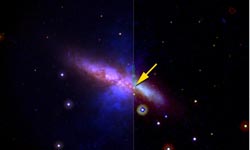NASA Spacecraft Take Aim At Nearby Supernova

Caption: <br>These Swift UVOT images show M82 before (left) and after the new supernova (right). The pre-explosion view combines data taken between 2007 and 2013. The view showing SN 2014J (arrow) merges three exposures taken on Jan. 22, 2014. Mid-ultraviolet light is shown in blue, near-UV light in green, and visible light in red. The image is 17 arcminutes across, or slightly more than half the apparent diameter of a full moon.<br>Image Credit: NASA/Swift/P. Brown, TAMU<br>
The blast, designated SN 2014J, occurred in the galaxy M82 and lies only about 12 million light-years away. This makes it the nearest optical supernova in two decades and potentially the closest type Ia supernova to occur during the life of currently operating space missions.
To make the most of the event, astronomers have planned observations with the NASA/ESA Hubble Space Telescope and NASA's Chandra X-ray Observatory, Nuclear Spectroscopic Telescope Array (NuSTAR), Fermi Gamma-ray Space Telescope, and Swift missions.
As befits its moniker, Swift was the first to take a look. On Jan. 22, just a day after the explosion was discovered, Swift's Ultraviolet/Optical Telescope (UVOT) captured the supernova and its host galaxy.
Remarkably, SN 2014J can be seen on images taken up to a week before anyone noticed its presence. It was only when Steve Fossey and his students at the University of London Observatory imaged the galaxy during a brief workshop that the supernova came to light.
“Finding and publicizing new supernova discoveries is often the weak link in obtaining rapid observations, but once we know about it, Swift frequently can observe a new object within hours,” said Neil Gehrels, the mission's principal investigator at NASA's Goddard Space Flight Center in Greenbelt, Md.
Although the explosion is unusually close, the supernova's light is attenuated by thick dust clouds in its galaxy, which may slightly reduce its apparent peak brightness.
“Interstellar dust preferentially scatters blue light, which is why Swift's UVOT sees SN 2014J brightly in visible and near-ultraviolet light but barely at all at mid-ultraviolet wavelengths,” said Peter Brown, an astrophysicist at Texas A&M University who leads a team using Swift to obtain ultraviolet observations of supernovae.
However, this super-close supernova provides astronomers with an important opportunity to study how interstellar dust affects its light. As a class, type Ia supernovae explode with remarkably similar intrinsic brightness, a property that makes them useful “standard candles” — some say “standard bombs” — for exploring the distant universe.
Brown notes that X-rays have never been conclusively observed from a type Ia supernova, so a detection by Swift's X-ray Telescope, Chandra or NuSTAR would be significant, as would a Fermi detection of high-energy gamma rays.
A type Ia supernova represents the total destruction of a white dwarf star by one of two possible scenarios. In one, the white dwarf orbits a normal star, pulls a stream of matter from it, and gains mass until it reaches a critical threshold and explodes. In the other, the blast arises when two white dwarfs in a binary system eventually spiral inward and collide.
Either way, the explosion produces a superheated shell of plasma that expands outward into space at tens of millions of miles an hour. Short-lived radioactive elements formed during the blast keep the shell hot as it expands. The interplay between the shell's size, transparency and radioactive heating determines when the supernova reaches peak brightness. Astronomers expect SN 2014J to continue brightening into the first week of February, by which time it may be visible in binoculars.
M82, also known as the Cigar Galaxy, is located in the constellation Ursa Major and is a popular target for small telescopes. M82 is undergoing a powerful episode of star formation that makes it many times brighter than our own Milky Way galaxy and accounts for its unusual and photogenic appearance.
Francis Reddy
NASA's Goddard Space Flight Center, Greenbelt, Md.
Media Contact
All latest news from the category: Physics and Astronomy
This area deals with the fundamental laws and building blocks of nature and how they interact, the properties and the behavior of matter, and research into space and time and their structures.
innovations-report provides in-depth reports and articles on subjects such as astrophysics, laser technologies, nuclear, quantum, particle and solid-state physics, nanotechnologies, planetary research and findings (Mars, Venus) and developments related to the Hubble Telescope.
Newest articles

Superradiant atoms could push the boundaries of how precisely time can be measured
Superradiant atoms can help us measure time more precisely than ever. In a new study, researchers from the University of Copenhagen present a new method for measuring the time interval,…

Ion thermoelectric conversion devices for near room temperature
The electrode sheet of the thermoelectric device consists of ionic hydrogel, which is sandwiched between the electrodes to form, and the Prussian blue on the electrode undergoes a redox reaction…

Zap Energy achieves 37-million-degree temperatures in a compact device
New publication reports record electron temperatures for a small-scale, sheared-flow-stabilized Z-pinch fusion device. In the nine decades since humans first produced fusion reactions, only a few fusion technologies have demonstrated…





















